This Content Covers:
- Make Random Groups in Excel
- Use of RANDBETWEEN Function
- Use of CHOOSE Function
- Use of combining RANDBETWEEN and CHOOSE Functions
- Randomly assign people in the groups in Excel
- Formula
- Explanation of formula
- Example
- Alternate solution
- CEILING Function
- Explanation of CEILING function
- Explanation with example
- Make Random Groups in Excel
In certain situations, it may be desirable to generate groups for a list of names or randomly allocate data to groups. You can quickly create random groups for a set of data in Microsoft Excel by using a formula.
The RANDBETWEEN and CHOOSE Functions can be used to randomly allocate items (data, people, etc.) to groups.
- Use of RANDBETWEEN Function
Procedure of using RANDBETWEEN Function
Step 1: Next to the list you want to divide into random groups, choose a blank cell, then enter the RANDBETWEEN function, outlined in Red below.
After applying the function or formula, the result looks like below.
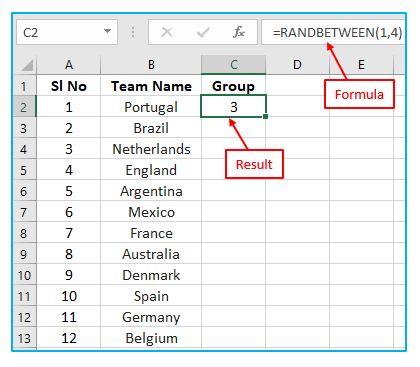
Step 2: After that, to fill all the cells, pull the “Fill Handle” further. The result is outlined in Red below.
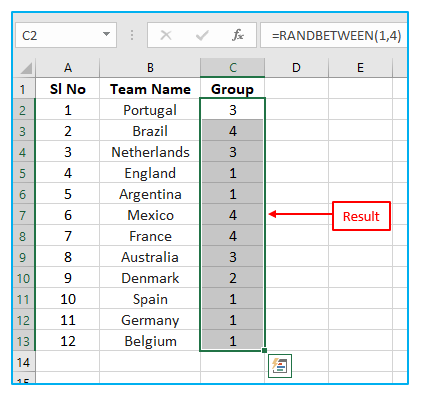
- Use of CHOOSE Function:
Procedure of using CHOOSE Function:
Step 1: Next to the list you want to divide into random groups, choose a blank cell, then enter the CHOOSE function, outlined in Red below.
After applying the function or formula, the result looks like below.
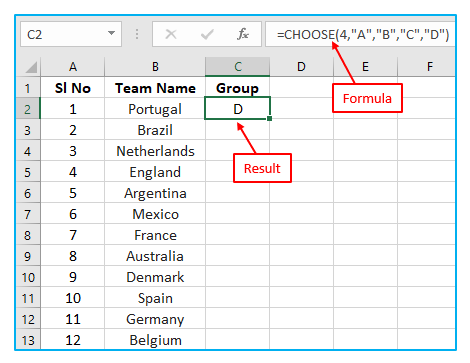
Step 2: After that, to fill all the cells, pull the “Fill Handle” further. The result is outlined in Red below.
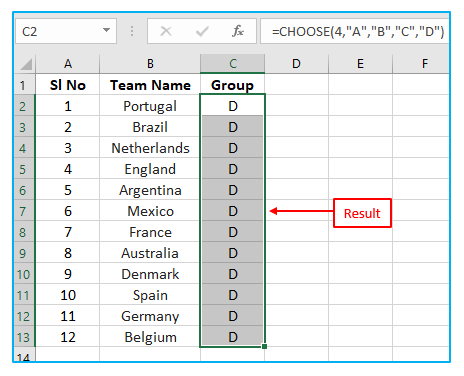
- Use of combination of RANDBETWEEN and CHOOSE Functions
Combining the two allows us to assign teams to groups by randomly “choosing” one item from a list.
Procedure of combining RANDBETWEEN and CHOOSE Functions:
Step 1: Next to the list you want to divide into random groups, choose a blank cell, then enter the function or formula, outlined in Red below.
After applying the function or formula, the result looks like below.
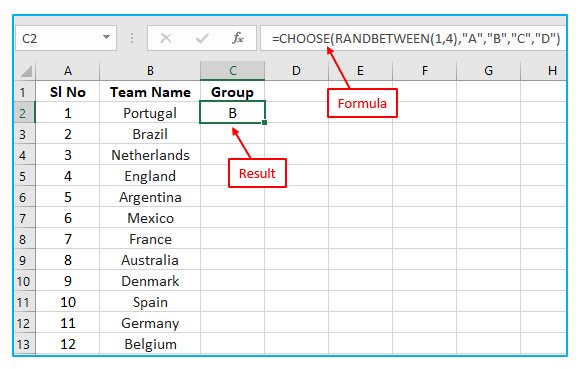 Step 2: After that, to fill all the cells, pull the “Fill Handle” further. The result is outlined in Red below.
Step 2: After that, to fill all the cells, pull the “Fill Handle” further. The result is outlined in Red below.
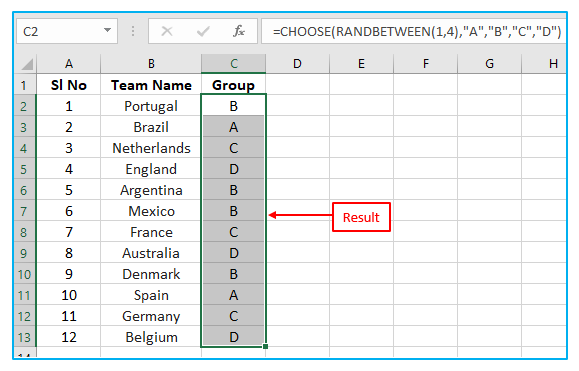
- Randomly assign people in the groups in Excel
Sometimes we have to pick groups at random. Although it could appear like a difficult undertaking, Excel makes it incredibly simple to complete by using formula.
Here, we may make use of a formula produced by combining the Excel RANK and ROUNDUP tools. Additionally, we employ a helper column where the RAND function is utilized to produce values at random.
- Formula
We use the formula to assign individuals into groups at random.
=ROUNDUP(RANK(A1,randoms)/size,0)
For each element, the aforementioned formula returns a group number.
Here,
“size” and “randoms” are called range.
The Excel RAND function creates the helper column “Random”.
- Explanation of formula:
The Excel RANK function is a built-in feature that provides the position of a given number in an array or huge collection of numbers. In Excel, this function falls under the category of built-in statistical function.
Another built-in function in Excel is the ROUNDUP function, which returns a value that has been rounded to a predetermined number of digits. This function deviates from zero. It can be used effectively as an Excel worksheet function and is categorized as a Trig or Math function.
- Example:
Procedure of assigning people in the groups randomly in Excel
Step 1: Let’s use a case where we have to assign teams to random groups. We apply the formula shown in D2 to build groups.
=ROUNDUP(RANK(A1,randoms)/size,0)
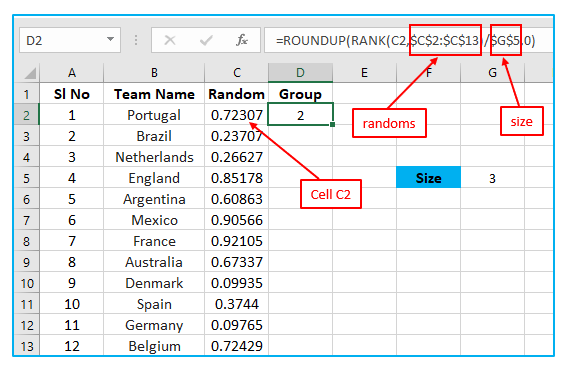 Step 2: After that, to fill all the cells, pull the “Fill Handle” further. The result is outlined in Red below.
Step 2: After that, to fill all the cells, pull the “Fill Handle” further. The result is outlined in Red below.
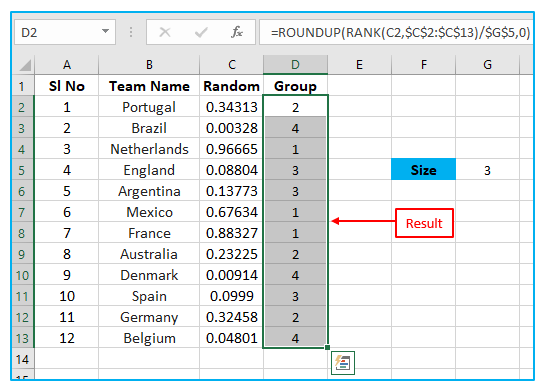 The RAND function, which would produce random numbers, can also be used. Every time we alter a value in Microsoft Excel, this function will continue to produce random values.
The RAND function, which would produce random numbers, can also be used. Every time we alter a value in Microsoft Excel, this function will continue to produce random values.
- Alternate solution:
The CEILING function, another built-in Excel function, can be used as an alternate method of assigning random values.
- CEILING Function:
We can use CEILING function or formula to assign individuals into groups at random.
=CEILING(RANK(C5,random)/size,1)
- Explanation of CEILING function:
In place of the ROUNDUP function, you can use this function. The ceiling function rounds up, but it does so to a specific multiple rather than to a specific number of decimal places.
- Explanation with example:
Procedure of assigning people in the groups randomly in Excel using CEILING function:
Step 1: Let’s use a case where we have to assign teams to random groups. We apply the formula shown in D2 to build groups.
=CEILING(RANK(C5,random)/size,1)
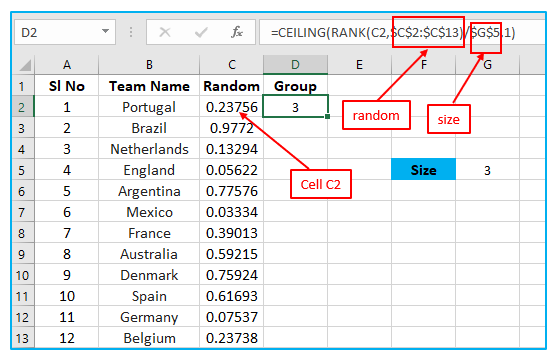
Here, “random” is the name of the range [C2:C13] and “size” is the named range[G5].
Step 2: After that, to fill all the cells, pull the “Fill Handle” further. The result is outlined in Red below.
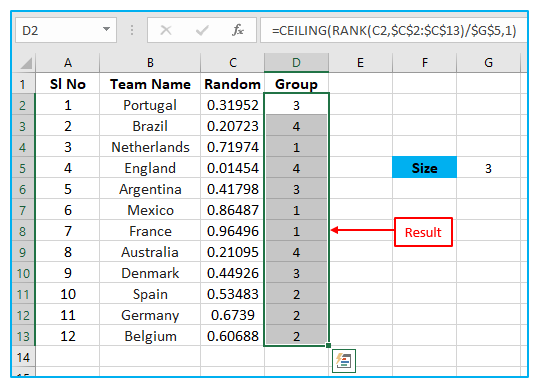
You may be interested:
